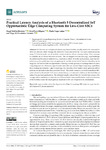Practical latency analysis of a Bluetooth 5 decentralized IoT Opportunistic Edge Computing System for low-cost SBCs

Use este enlace para citar
http://hdl.handle.net/2183/33097Coleccións
- Investigación (FIC) [1685]
Metadatos
Mostrar o rexistro completo do ítemTítulo
Practical latency analysis of a Bluetooth 5 decentralized IoT Opportunistic Edge Computing System for low-cost SBCsData
2022-10Cita bibliográfica
Á. Niebla-Montero, I. Froiz-Míguez, P. Fraga-Lamas, and T. M. Fernández-Caramés, “Practical Latency Analysis of a Bluetooth 5 Decentralized IoT Opportunistic Edge Computing System for Low-Cost SBCs,” Sensors, vol. 22, no. 21, p. 8360, Oct. 2022, doi: 10.3390/s22218360.
Resumo
[Abstract]: IoT devices can be deployed almost anywhere, but they usually need to be connected to other IoT devices, either through the Internet or local area networks. For such communications, many IoT devices make use of wireless communications, whose coverage is key: if no coverage is available, an IoT device becomes isolated. This can happen both indoors (e.g., large buildings, industrial warehouses) or outdoors (e.g., rural areas, cities). To tackle such an issue, opportunistic networks can be useful, since they use gateways to provide services to IoT devices when they are in range (i.e., IoT devices take the opportunity of having a nearby gateway to exchange data or to use a computing service). Moreover, opportunistic networks can provide Edge Computing capabilities, thus creating Opportunistic Edge Computing (OEC) systems, which deploy smart gateways able to perform certain tasks faster than a remote Cloud. This article presents a novel decentralized OEC system based on Bluetooth 5 IoT nodes whose latency is evaluated to determine the feasibility of using it in practical applications. The obtained results indicate that, for the selected scenario, the average end-to-end latency is relatively low (736 ms), but it is impacted by factors such as the location of the bootstrap node, the smart gateway hardware or the use of high-security mechanisms.
Palabras chave
Opportunistic networks
Opportunistic edge computing
OEC systems
Opportunistic IoT
Bluetooth 5
Decentralized IoT
Opportunistic edge computing
OEC systems
Opportunistic IoT
Bluetooth 5
Decentralized IoT
Versión do editor
Dereitos
Atribución 3.0 España






